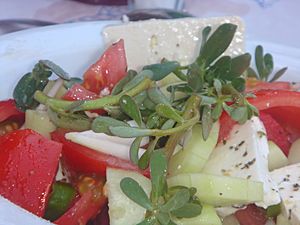Spring greens facts for kids

Spring greens are the fresh, young leaves and new growth of many plants. They are best to eat when they first sprout in the spring. As these leafy plants get older, they can become tough or taste bitter. Some might even develop substances that are not good to eat. Many Native American cultures have traditionally gathered spring vegetables for food.
Finding Wild Greens Safely

Most leafy vegetables are hard to store for a long time. Growing and shipping them to stores can create a lot of pollution and plastic waste. Some people suggest that gathering spring greens from the wild, called foraging, could help reduce this impact.
However, it's very important to be careful when foraging. You need to understand the possible risks. Many spring greens grow like "weeds" in places where the ground has been disturbed. Plants growing in soil with heavy metals or pesticides can absorb these harmful substances. Also, if you pick the wrong plant, you might accidentally eat something poisonous. Always be sure you know exactly what you are picking!
Types of Spring Greens
Here are some examples of spring greens that people enjoy:
- Brambles (Rubus species): The soft, new shoots of plants like salmonberry and thimbleberry are eaten by many Native American groups, such as the Séliš. These "sprouts" are only available for a few weeks each spring.
- Chickweed (Stellaria media): This plant comes from Eurasia but now grows all over the world, often as a weed. Its new growth can be picked from March to April. If it gets too old, it becomes stringy and tough.
- Cleavers (Galium species): Cleavers are common in temperate areas around the world. The seeds of some types can even be used as a coffee substitute. Young leaves can be eaten raw or cooked. Older leaves become too fibrous to enjoy.
- Dandelions (Taraxacum officinale): Dandelions have been used in cooking for a long time. Their leaves are full of vitamins and nutrients that are good for you. You can pick young, tender leaves from the center of the plant. Older leaves get very bitter, especially after a lot of sunlight.
- Japanese Helwingia (Helwingia japonica): The young leaves and flowers of this plant are eaten or cooked in Japan.
- Honewort (Cryptotaenia canadensis): The young leaves and stems of honewort can be boiled. They are also used as a seasoning, much like parsley.
- Lamb's Quarters (Chenopodium album): This plant often grows as a "weed" worldwide. However, it is also grown on purpose in Northern India and other places. Wild leaves can be picked from spring to early summer. They are best when young, but you can also pick new growth from the top of the plant later in the season. They are great in salads, pesto, and soups.
- Purslane (Portulaca oleracea): Purslane is found all over the world. You can eat it fresh, stir-fry it, or add it to soups.
- Stinging Nettles (Urtica dioica): Stinging nettles are native to Eurasia and Western Africa, but now grow everywhere. They have tiny stinging hairs that can cause a mild itch when touched. But these hairs are easily made harmless by boiling, cooking with heat, or even drying the plant.
- Violets (Viola species): Most violet plants have edible leaves and flowers. They taste best in the spring. However, their leaves contain substances called saponins. Eating too many might upset your stomach.
- Wood Sorrel (Oxalis stricta): Wood sorrel leaves are edible. They contain oxalic acid, which gives them a tart, sour taste. You should not eat them in very large amounts.


